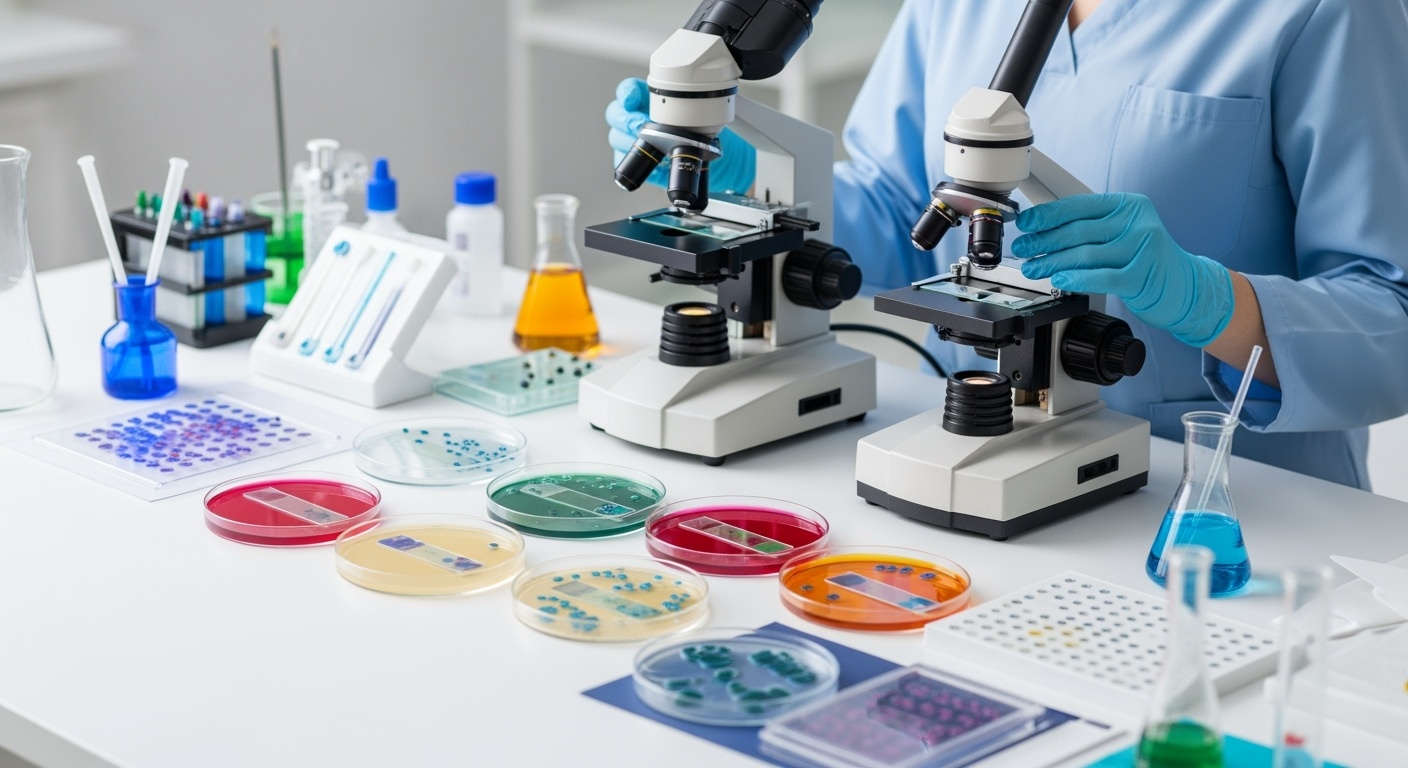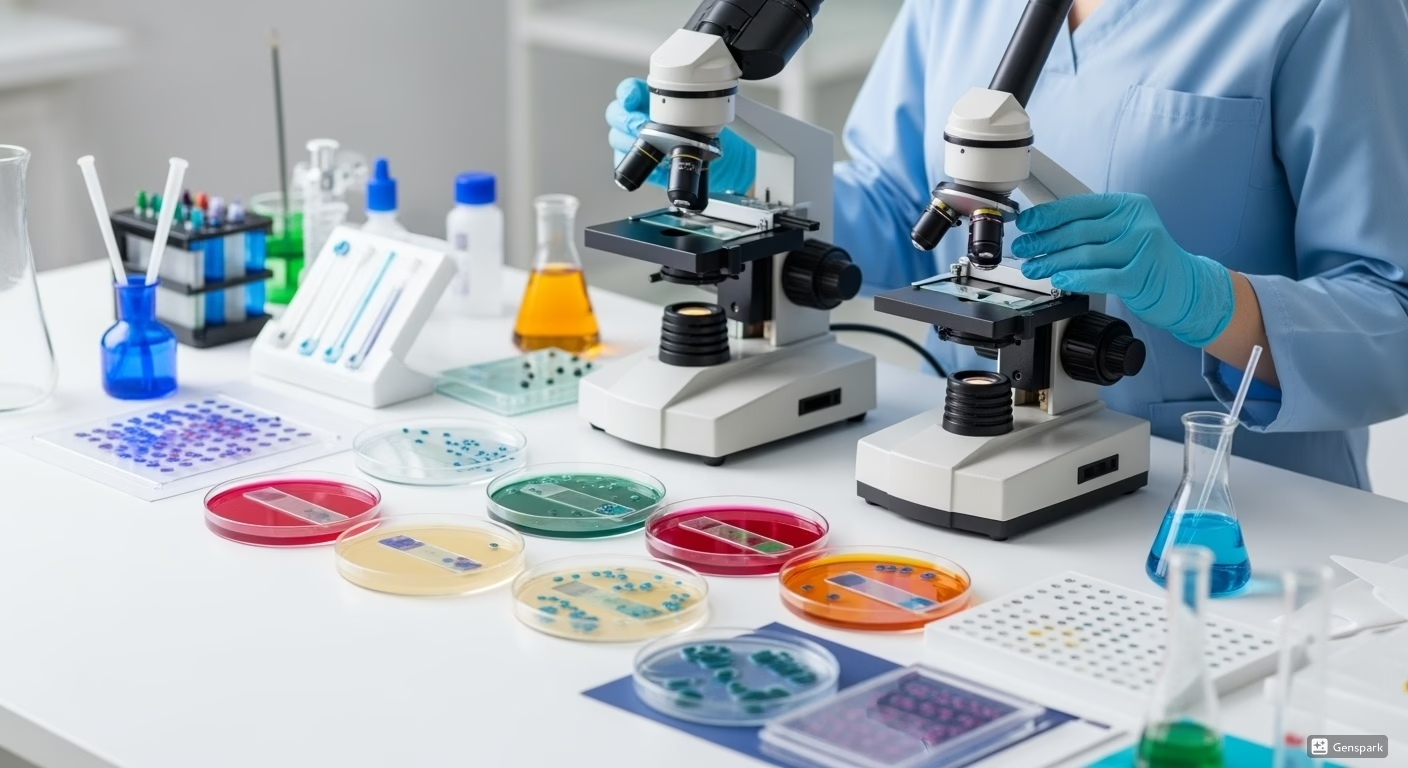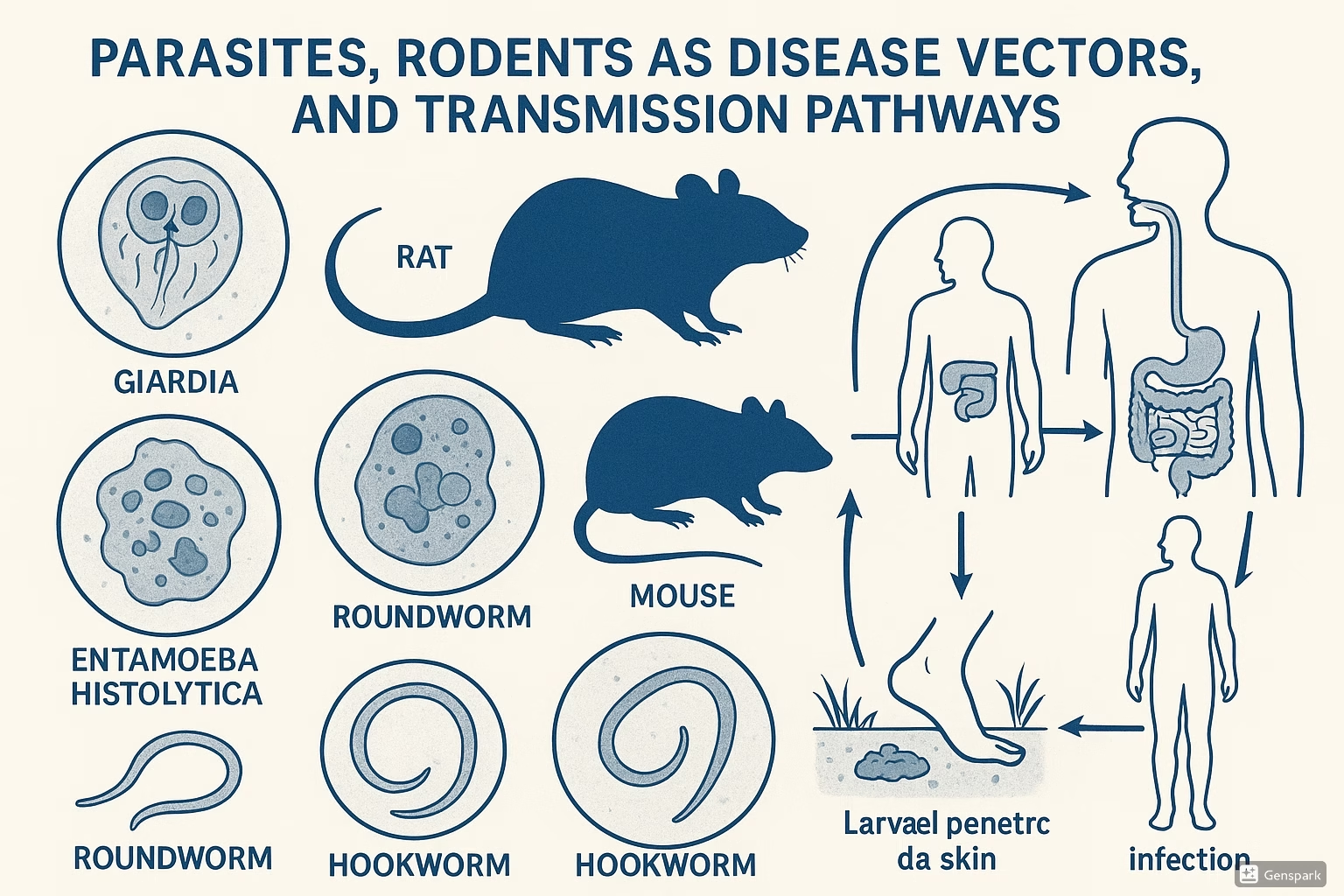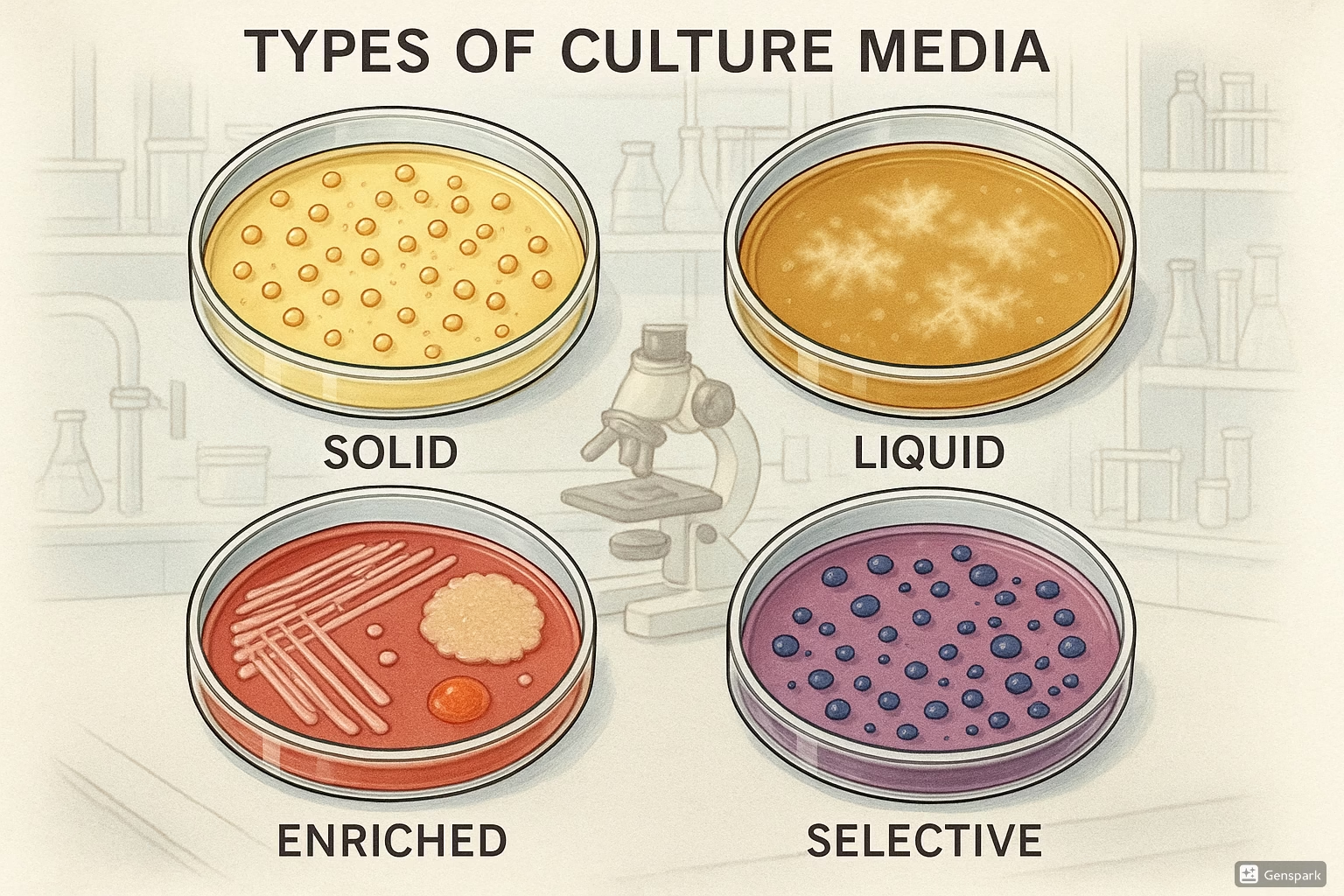Laboratory Methods for Identification of Microorganisms
Comprehensive Nursing Study Guide

Introduction to Microbial Identification
Laboratory identification of microorganisms is fundamental to modern healthcare and essential for nursing practice. As a nurse, understanding these techniques enables you to better interpret laboratory results, implement appropriate infection control measures, and provide optimal patient care.
Why This Matters in Nursing
- Patient Safety: Rapid identification prevents healthcare-associated infections
- Treatment Decisions: Accurate diagnosis guides antibiotic selection
- Infection Control: Proper isolation precautions based on organism type
- Quality Care: Understanding results improves patient education and care planning
Fundamental Principles of Staining
Staining techniques work by utilizing the differential uptake of dyes by various cellular components. The process involves three key principles:
Electrostatic Attraction
Charged dye molecules bind to oppositely charged cellular structures
Chemical Affinity
Specific dyes have affinity for particular cellular components
Permeability Differences
Cell wall composition affects dye penetration and retention
Simple Staining Techniques
Simple staining uses a single dye to color all bacterial cells uniformly, allowing visualization of cell morphology, size, and arrangement. This is the most basic staining technique and serves as an introduction to microscopic examination.
Memory Aid: “SIMPLE”
- Single dye used
- Identifies morphology
- Methylene blue most common
- Positive charge attracts to negative bacteria
- Less than 5 minutes procedure
- Easy technique for beginners
Common Simple Stains
Methylene Blue
- • Most commonly used basic dye
- • Stains all bacteria blue
- • Excellent for visualizing cell morphology
- • Safe and easy to use
Safranin
- • Basic dye producing red color
- • Often used as counterstain
- • Good contrast against white background
- • Suitable for routine morphology studies
Step-by-Step Procedure
Prepare the Smear
Create a thin, even smear of the specimen on a clean glass slide
Air Dry and Heat Fix
Allow to air dry completely, then pass through flame 3 times
Apply Primary Stain
Cover with methylene blue for 1-2 minutes
Rinse and Dry
Gently rinse with distilled water and blot dry
Examine Under Microscope
Use oil immersion (100x) for optimal visualization
Differential Staining Methods
Differential staining techniques use multiple dyes to distinguish between different types of microorganisms or cellular structures. These methods provide crucial information for bacterial classification and identification, making them indispensable in clinical microbiology.
Nursing Clinical Correlation
Differential staining results directly impact patient care decisions:
- Antibiotic Selection: Gram-positive vs. Gram-negative results guide initial therapy
- Isolation Precautions: AFB positive results require airborne precautions
- Infection Control: Spore-forming organisms need enhanced disinfection protocols
- Patient Education: Understanding organism characteristics helps explain treatment duration
Key Principles
Primary Stain
Initial dye that colors all cells
Creates the base coloration for all microorganisms present
Decolorizer
Removes primary stain selectively
Critical step that differentiates organism types
Counterstain
Secondary dye of contrasting color
Makes decolorized organisms visible
Mordant
Fixes primary stain to cellular structures
Enhances binding and prevents easy removal
Gram’s Staining Protocol
Gram staining, developed by Hans Christian Gram in 1884, remains the most important differential staining technique in clinical microbiology. It divides bacteria into two major groups based on cell wall composition: Gram-positive (thick peptidoglycan layer) and Gram-negative (thin peptidoglycan layer with outer membrane).
Memory Mnemonic: “Come In And Stain”
Detailed Procedure
Primary Stain – Crystal Violet (60 seconds)
Flood the heat-fixed smear with crystal violet solution
Mordant – Iodine (60 seconds)
Apply iodine solution to fix the crystal violet
Decolorizer – Alcohol/Acetone (10-30 seconds)
Apply decolorizer until runoff is clear
Counterstain – Safranin (30 seconds)
Apply safranin to visualize decolorized bacteria
Clinical Significance
Gram-Positive Bacteria
Appearance: Purple/violet color
Cell Wall: Thick peptidoglycan layer (20-80 nm)
Examples: Staphylococcus, Streptococcus, Enterococcus
Antibiotic Sensitivity: Generally sensitive to beta-lactams
Gram-Negative Bacteria
Appearance: Pink/red color
Cell Wall: Thin peptidoglycan + outer membrane
Examples: E. coli, Pseudomonas, Klebsiella
Antibiotic Resistance: Outer membrane provides additional protection
Acid-Fast Bacilli (AFB) Staining
Acid-fast staining is a specialized differential technique used to identify mycobacteria and related organisms. These bacteria have a unique cell wall composition rich in mycolic acids, making them resistant to decolorization by acid-alcohol solutions.
Critical Nursing Alert
AFB-positive results require immediate implementation of airborne isolation precautions until tuberculosis is ruled out.
- • Patient must be placed in negative pressure room
- • All staff must wear N95 respirators or PAPR
- • Visitors require respiratory protection
- • Patient transport should be minimized
Methods of AFB Staining
Ziehl-Neelsen (Hot Method)
- Primary Stain: Carbol fuchsin with heat
- Decolorizer: 3% acid-alcohol
- Counterstain: Methylene blue
- Time: 45-60 minutes total
- Advantage: Traditional, reliable method
Kinyoun (Cold Method)
- Primary Stain: Carbol fuchsin (cold)
- Decolorizer: 3% acid-alcohol
- Counterstain: Methylene blue
- Time: 15-20 minutes total
- Advantage: No heat required, safer
Memory Aid: “Mycobacteria Are Really Tough”
- Mycolic acids in cell wall
- Acid-fast property
- Red color after staining
- Tuberculosis most important example
Ziehl-Neelsen Procedure
Heat-Fixed Smear
Prepare thick smear and heat-fix thoroughly
Primary Stain with Heat (5 minutes)
Apply carbol fuchsin and heat gently until steaming
Decolorize (3-5 minutes)
Apply 3% acid-alcohol until no more red color runs off
Counterstain (2 minutes)
Apply methylene blue, rinse, and dry
Examine Under Oil Immersion
AFB appear as bright red rods against blue background
Clinical Applications
Tuberculosis Diagnosis
Primary screening test for pulmonary and extrapulmonary TB
Treatment Monitoring
Serial AFB smears track treatment response
Atypical Mycobacteria
Identifies non-tuberculous mycobacteria (NTM)
Special Staining Techniques
Special staining methods target specific cellular structures or components that are not visualized by routine staining techniques. These methods provide detailed information about bacterial morphology and help identify unique characteristics essential for accurate species identification.
Clinical Relevance for Nurses
Special staining results provide crucial information for:
- Virulence Assessment: Capsulated organisms are often more pathogenic
- Disinfection Planning: Spore-formers require stronger disinfectants
- Treatment Duration: Some organisms require extended therapy
- Infection Control: Understanding organism resistance mechanisms
- Patient Education: Explaining why certain infections are difficult to treat
- Environmental Safety: Spore contamination concerns
Overview of Special Stains
Capsular Staining
- • Negative staining technique
- • Uses India ink or nigrosine
- • Visualizes polysaccharide capsules
- • Important for virulence assessment
Spore Staining
- • Malachite green with heat
- • Identifies endospores
- • Critical for Clostridium species
- • Important for sterilization
Fungal Stains
- • LPCB for morphology
- • KOH for direct examination
- • Identifies fungal elements
- • Rapid diagnostic tools
Capsular (Negative) Staining
Capsular staining, also known as negative staining, is used to visualize the polysaccharide or protein capsules that surround certain bacteria. Unlike positive staining, this technique colors the background while leaving the capsule and bacterial cell unstained.
Memory Aid: “HALO Effect”
- Halo appearance around bacteria
- Acidic dyes repelled by capsule
- Large capsules = increased virulence
- Outline visible against dark background
Principle of Negative Staining
Acidic Dyes Used
Negatively charged dyes (India ink, Nigrosine) are repelled by the negatively charged bacterial surface and capsule
Background Stained
The dye colors the background medium, creating contrast that makes unstained capsules visible as clear halos
Capsule Protection
The hydrophilic capsule prevents dye penetration, maintaining its transparent appearance
Procedure Steps
Step 1: Preparation
- • Use fresh bacterial culture
- • Clean glass slides essential
- • Room temperature procedure
- • No heat fixation required
Step 2: Mixing
- • Place small drop of India ink
- • Add bacterial sample
- • Mix gently with loop
- • Avoid excess manipulation
Step 3: Spreading
- • Use second slide at 45° angle
- • Create thin, even smear
- • Allow to air dry completely
- • Do not heat fix
Step 4: Examination
- • Use oil immersion lens
- • Look for clear halos
- • Dark background, clear capsules
- • Document capsule presence
Clinical Significance
Virulence Factor
Capsulated bacteria are generally more virulent as capsules help evade host immune responses
Important Capsulated Pathogens
- • Streptococcus pneumoniae – Pneumonia, meningitis
- • Haemophilus influenzae – Respiratory infections
- • Neisseria meningitidis – Meningitis
- • Klebsiella pneumoniae – Hospital-acquired infections
- • Cryptococcus neoformans – Opportunistic infections
- • Bacillus anthracis – Anthrax
Spore Staining Methods
Spore staining identifies bacterial endospores, which are highly resistant structures formed by certain bacteria under stress conditions. This staining technique is crucial for identifying spore-forming bacteria and understanding their resistance properties.
Infection Control Alert
Spore-forming bacteria require special considerations:
- • Standard disinfectants may not kill spores
- • Sterilization requires higher temperatures/longer times
- • Environmental contamination can persist
- • C. difficile spores survive alcohol-based sanitizers
Schaeffer-Fulton Method
Memory Aid: “Green Heat Makes Spores”
- Green malachite primary stain
- Heat application essential
- Malachite penetrates spore coat
- Safranin counterstains vegetative cells
Detailed Procedure
Primary Stain – Malachite Green (5 minutes)
Flood smear with malachite green and steam gently without boiling
Decolorization – Water Rinse
Rinse with distilled water to remove excess stain
Counterstain – Safranin (30 seconds)
Apply safranin to color decolorized vegetative cells
Types of Endospores
Terminal Spores
Location: At the end of bacterial cell
Appearance: “Drumstick” or “tennis racket”
Example: Clostridium tetani
Subterminal Spores
Location: Near the end but not terminal
Appearance: Oval shape near end
Example: Clostridium perfringens
Central Spores
Location: Center of bacterial cell
Appearance: Oval in middle of cell
Example: Bacillus anthracis
Clinical Importance
Healthcare-Associated Infections
Clostridioides difficile: Leading cause of antibiotic-associated diarrhea
- • Spores survive on surfaces for months
- • Resistant to alcohol-based hand sanitizers
- • Requires contact precautions
- • Soap and water handwashing essential
Bioterrorism Concerns
Bacillus anthracis: Anthrax spores as biological weapons
- • Highly resistant to environmental stress
- • Can remain viable for decades
- • Requires immediate reporting
- • Special handling procedures
LPCB and KOH Mount Techniques
Fungal identification requires specialized mounting techniques that can demonstrate morphological features like hyphae, spores, and reproductive structures. Lactophenol Cotton Blue (LPCB) and Potassium Hydroxide (KOH) preparations are essential tools in mycological diagnosis.
LPCB (Lactophenol Cotton Blue)
Components & Functions
- Lactophenol: Preserves fungal structures
- Cotton Blue: Stains chitin in cell walls
- Glycerol: Prevents drying
- Phenol: Kills organisms
Best Used For
- • Morphological identification
- • Permanent preparations
- • Detailed structural study
- • Culture examination
KOH Mount (10-20% KOH)
Mechanism of Action
- Dissolves: Host tissue debris
- Clears: Background material
- Preserves: Fungal elements
- Enhances: Visibility of hyphae
Best Used For
- • Direct clinical specimens
- • Rapid diagnosis
- • Emergency situations
- • Screening purposes
Memory Aid: “Fungi Love Blue, KOH Clears True”
- Fungi structures stained blue
- Lactophenol preserves morphology
- Blue dye highlights chitin
- KOH dissolves tissue
- Clears background debris
- True fungal elements remain
Detailed Procedures
LPCB Mount Procedure
Sample Preparation
Use sterile technique to obtain small amount of fungal growth
Add LPCB
Place 1-2 drops of LPCB solution on clean slide
Mix Gently
Tease fungal material into LPCB with mounting needles
Cover Slip
Apply cover slip carefully to avoid air bubbles
Examine
Start with 10x, progress to 40x magnification
KOH Mount Procedure
Specimen Collection
Collect scales, hair, or tissue sample
Add KOH
Apply 1-2 drops of 10-20% KOH solution
Gentle Heating
Warm gently (do not boil) to accelerate clearing
Wait & Cover
Allow 5-10 minutes for clearing, add cover slip
Microscopy
Examine for hyphae, spores, and budding yeasts
What to Look For
Hyphae
- • Septate vs. non-septate
- • Branching patterns
- • Hyphal width
- • Pigmentation
Spores
- • Conidia shape & size
- • Arrangement patterns
- • Surface characteristics
- • Color variations
Yeasts
- • Budding patterns
- • Cell morphology
- • Pseudohyphae formation
- • Capsule presence
Nursing Applications & Clinical Relevance
Understanding laboratory identification methods is crucial for nursing practice. This knowledge directly impacts patient safety, infection control measures, treatment decisions, and quality of care. Nurses must be able to interpret results and implement appropriate interventions based on microbiological findings.
Core Nursing Competencies
Assessment Skills
- • Recognize signs of infection
- • Identify high-risk patients
- • Monitor treatment response
- • Document findings accurately
Implementation Skills
- • Proper isolation precautions
- • Medication administration
- • Patient education
- • Family communication
Specimen Collection Guidelines
Pre-Collection Considerations
- Timing: Collect before antibiotic therapy when possible
- Site Selection: Choose appropriate anatomical location
- Patient Preparation: Explain procedure and obtain consent
- Equipment: Ensure sterile collection tools available
Collection Technique
- Aseptic Technique: Prevent contamination throughout
- Adequate Volume: Collect sufficient sample for testing
- Proper Labeling: Include all required patient information
- Rapid Transport: Deliver to laboratory promptly
Isolation Precautions Based on Results
Airborne Precautions
When Required:
- • AFB-positive sputum (suspected TB)
- • Confirmed Mycobacterium tuberculosis
- • Varicella-zoster virus
- • Measles virus
Nursing Actions:
- • Negative pressure room
- • N95 respirator or PAPR
- • Minimize patient transport
- • Patient mask during transport
Droplet Precautions
When Required:
- • Streptococcus pneumoniae (pneumonia/meningitis)
- • Neisseria meningitidis
- • Haemophilus influenzae
- • Influenza virus
Nursing Actions:
- • Surgical mask within 3 feet
- • Private room preferred
- • Patient mask during transport
- • Standard hand hygiene
Contact Precautions
When Required:
- • Clostridioides difficile (spore-positive)
- • MRSA, VRE colonization/infection
- • Multidrug-resistant organisms
- • Skin/wound infections
Nursing Actions:
- • Gloves and gown for all contact
- • Dedicated equipment when possible
- • Enhanced hand hygiene
- • Environmental cleaning protocols
Antibiotic Selection Guidance
Gram-Positive Coverage
First-Line Options
- • Beta-lactams (penicillins, cephalosporins)
- • Vancomycin for MRSA
- • Linezolid for VRE
Nursing Considerations
- • Monitor for allergic reactions
- • Check renal function for vancomycin
- • Assess treatment response
Gram-Negative Coverage
Broad-Spectrum Options
- • Fluoroquinolones
- • Extended-spectrum cephalosporins
- • Carbapenems for resistant organisms
Nursing Considerations
- • Monitor for C. diff development
- • Watch for drug interactions
- • Assess for side effects
Patient Education Strategies
Medication Compliance
- • Complete full course of antibiotics
- • Take medications as prescribed
- • Report side effects promptly
- • Don’t share medications
Infection Prevention
- • Proper hand hygiene techniques
- • Avoid close contact when infectious
- • Cover coughs and sneezes
- • Maintain good personal hygiene
Follow-up Care
- • Attend scheduled appointments
- • Report worsening symptoms
- • Understand isolation requirements
- • Know when to seek emergency care
Quality Improvement Initiatives
Antimicrobial Stewardship
Nurses play a crucial role in promoting appropriate antibiotic use:
- • Obtain cultures before antibiotics when possible
- • Monitor for treatment response and side effects
- • Advocate for culture-directed therapy
- • Educate patients about antibiotic resistance
Infection Prevention Metrics
Key performance indicators nurses should monitor:
- • Healthcare-associated infection rates
- • Hand hygiene compliance
- • Isolation precaution adherence
- • Environmental cleaning effectiveness
Summary & Key Takeaways
Essential Learning Points
- • Staining techniques provide crucial information for bacterial identification and treatment decisions
- • Gram staining remains the most important differential technique in clinical microbiology
- • AFB staining is critical for tuberculosis diagnosis and requires immediate isolation precautions
- • Special stains reveal unique bacterial structures essential for species identification
- • Proper specimen collection and handling directly impact diagnostic accuracy
- • Understanding results enables appropriate nursing interventions and patient care
Clinical Application
- • Implement appropriate isolation precautions based on organism type
- • Monitor patient response to antimicrobial therapy
- • Educate patients and families about infection prevention
- • Collaborate with healthcare team for optimal outcomes
- • Participate in antimicrobial stewardship programs
- • Maintain competency in infection control practices
Remember: Your understanding of microbiology directly impacts patient safety and quality of care.
Continue learning, stay current with best practices, and always prioritize evidence-based nursing care.



